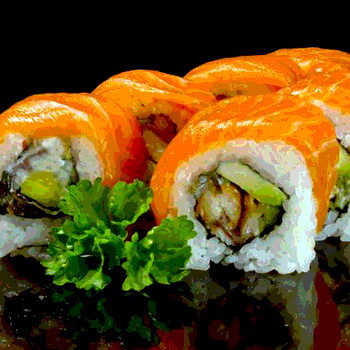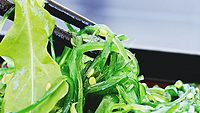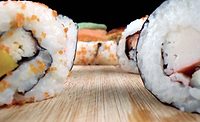Is My Sushi Safe? Why Government Regulation Is Coming to Sushi

I have been involved in the sushi industry since 2000 when my husband, Thihan Tun, and I opened Tun Asian Foods. We were an exclusive on-site sushi provider for Stop & Shop Supermarkets between 2002 and 2005. In 2005, we parted ways with Stop & Shop and decided to change our focus to delivery sushi in the New England region. Since then we have worked to provide safe and delicious food to businesses throughout the region.
Our strong focus on food safety came about due to our decision to focus on delivering fresh sushi. We already had a basic on-site Hazard Analysis and Critical Control Points (HACCP) plan and Standard Operating Procedures, but delivering fresh sushi requires special handling due to perishability issues. This caused Edo Sushi Express to begin the long road to a deeper understanding of sushi food safety. One of the results of this road was the law in Connecticut changing the way the health department looks at sushi rice.
Sushi is a traditional Japanese food that has been incorporated into the American cuisine, and as it has grown in popularity throughout the country, the health authorities in states and municipalities have had to grapple with the issue of food safety. Sushi is a Japanese word that means “seasoned rice.” And it is the sushi rice that concerns many health officials. The concern for health officials is the growth of bacteria that will normally begin growing in food held at room temperature within 2 hours.
In the United States, very few people die from eating sushi. Death from eating bad sushi is usually attributed to fugu, a type of poisonous fish rarely eaten in the United States. People do get sick from eating sushi, but the cause for illness is usually poorly handled fish. An example of this occurred earlier this year with a Salmonella outbreak caused by raw tuna. Salmonella is caused when food is exposed to feces. It is highly likely that the fish processor, in China or Indonesia, washed the tuna with dirty water. Raw fish to be used in sushi must be handled with care. Salmonella bacteria will not die if the fish is frozen, it will only stop growing.
A guide was released in 2004 through the Association of Food and Drug Officials, which had spent 3 years studying food safety and sushi operations. This was a special project funded through the U.S. Department of Agriculture Cooperative State Research and Extension at the University of Florida. This guide is called “Guidance for Processing Sushi in Retail Operations.” It is a thorough and complete explanation of the processes needed to make safe sushi in any retail or commercial setting. On page 8 of this guide, it states: “Properly acidified rice is not considered a potentially hazardous food.”
Sushi rice as a cause of human illness or death could not be found by this author. However, local health officials get very concerned when sushi rice is held in a rice warmer with a temperature of approximately 110 °F. Rice falls under the category of starchy foods served warm during meals. Normally, it would be held at a temperature of 135 °F or above to avoid bacterial growth. If the rice is not acidified, the temperature must be below 41 °F or above 135 °F.
Sushi chefs in the United States are usually trained by their peers and/or the companies they work for. The lead sushi chef must usually have an up-to-date ServSafe food handling license. This license trains the chef in bacterial growth; safe food handling techniques; cross-contamination; allergens; and sanitation. It is a requirement for most sushi bars.
Another requirement for most sushi bars today is an HACCP plan. The HACCP plan will document the risks involved with making sushi and make note of the need for rice acidification. The seasoned vinegar added to sushi rice acidifies it. The pH must be maintained below 4.6. Acidified rice is considered, in most places, to be considered potentially nonhazardous.
In fact, sushi rice is not a food hazard if it is made correctly. The preparation of sushi rice is different than regular rice. After the rice is steamed, it is cooled for a short time; seasoned rice vinegar is then mixed in with the cooked rice. It is the responsibility of the sushi chef to check the pH level of the rice using litmus paper or a pH testing monitor. The pH level is recorded in a pH log. This pH log is a tool for the local health official to check on the safety of the sushi rice.
In Connecticut, as a sushi bar operator and sushi supplier, our company has had to deal with the lack of a state-wide accurate policy on sushi rice safety. This lack of a coherent policy has made the actions of local health officials subjective about sushi rice. A sushi chef in one health district is met with differing requirements from a health district in the next county. Some examples of subjective decisions by health inspectors include:
1) A health inspector stated that after 2 hours at room temperature, the sushi rice had to be discarded.
2) A different health inspector insisted that sushi rice had to be held at 41 °F while making sushi.
3) A third health inspector insisted that the rice had to be above 135 °F at all times during the sushi-making process.
These were clear examples of how the lack of a state-wide food safety policy for sushi rice leads to confusion for the sushi chef trained in rice acidification. In fact, with all the discussion about sushi rice, the fragility of fish at room temperature was never mentioned in any of these situations.
The only way to deal with this type of situation is to change the law. If there is no law, then it needs to be created. Most states have different agencies dealing with different food venues. They might include the Department of Agriculture (grocery stores), Department of Public Health (catering, special events) and Department of Consumer Protection (restaurants). Interestingly, food safety laws and rules are not always shared between agencies. This is true in Connecticut. The law regarding sushi rice has to be changed on a per agency basis.
The Connecticut sushi rice law is the only one of its kind in the United States. It was signed by Governor Malloy in July 2015. Prior to this law, the Department of Public Health and local health departments were not required to allow acidification of sushi rice as an alternative to refrigeration. This new law gives the Department of Public Health the flexibility to make specific demands that will more than likely include a pH log, a rice recipe tested by a lab and an HACCP plan. The final text of the law reads as follows:
“Not later than October 1, 2016, the Commissioner of Public Health…with the Commissioner of Consumer Protection, shall adopt regulations…to allow the acidification of sushi rice as an alternative to temperature control under specified circumstances.”
Sushi rice is not dangerous if it is made at the correct pH. An experienced sushi chef understands how to make sushi rice correctly. The recipe only changes when the al dente texture of the rice is changed. The only recipe change would be in the amount of water used to steam the rice. The vinegar and pH would remain the same.
Many states have regulations for sushi rice that are tied to time and temperature. The number of hours that the sushi rice is allowed to stay at room temperature varies from state to state. The culture of food safety is such that being overly careful about bacterial growth is now the norm. However, in the process, the sushi producer must be extremely flexible to meet the demands of health authorities who base their decisions more on opinion than on real fact. Simply put, if you buy commercial mayonnaise, it is not hot packed and is considered stable at room temperature because of the pH level. The pH level of commercial mayonnaise is between 4.3 and 4.5. Therefore, because the commercial manufacturing of mayonnaise follows U.S. Food and Drug Administration standards providing acidification so that the product “contains sufficient amounts of acid to kill Salmonella and some other harmful foodborne bacteria” says Michael P. Doyle, Ph.D., regents professor and director of the Center for Food Safety at the University of Georgia. Why do people refrigerate their mayonnaise? They do not have to until they put a dirty spoon or knife into it, thus creating cross-contamination. The same vinegar and salt requirements for mayonnaise apply to sushi rice. But, for some reason there is less understanding about pickled rice.
As time passes and more people consume sushi, it will become necessary to truly understand the food safety issues for sushi. Food safety in sushi is based in two different points: fish quality and rice acidification. It is time to learn the truth about sushi rice and its hazards.
Cynthia LaBelle-Tun is president of Edo Sushi Express.
Looking for a reprint of this article?
From high-res PDFs to custom plaques, order your copy today!





